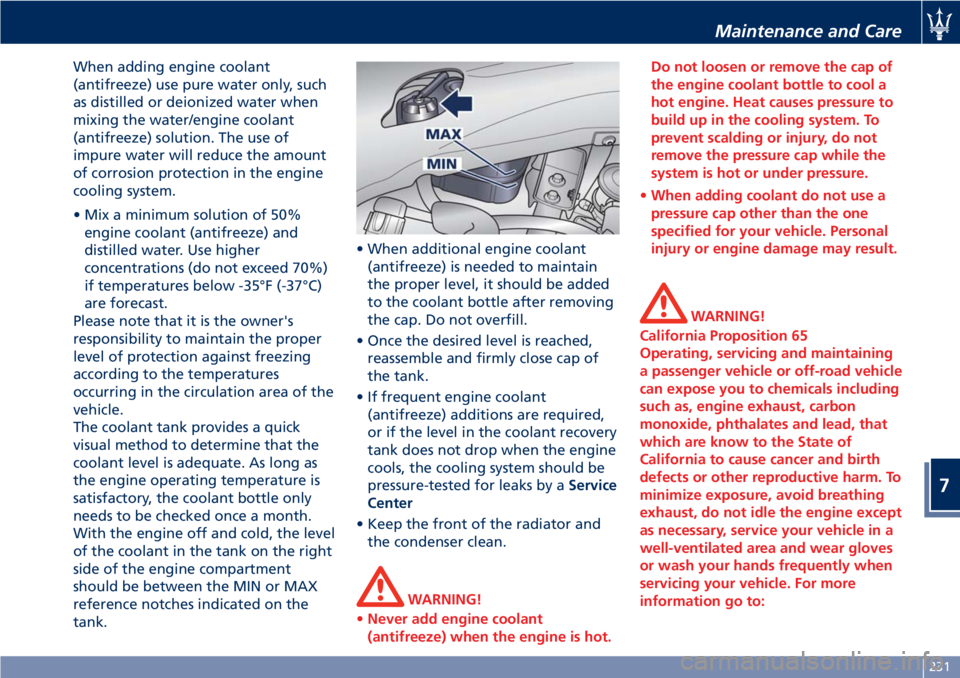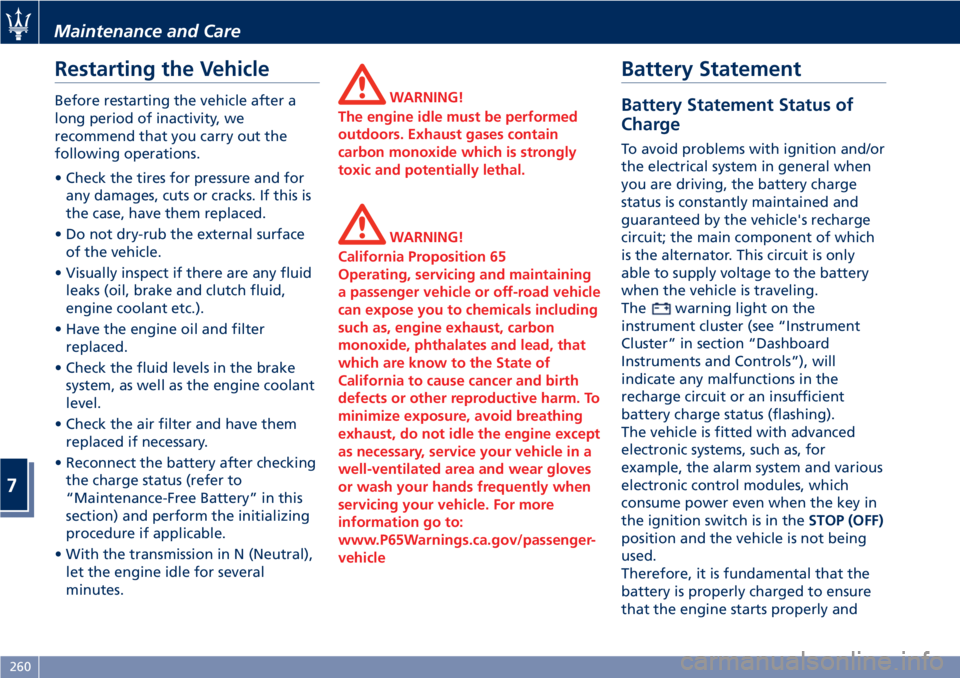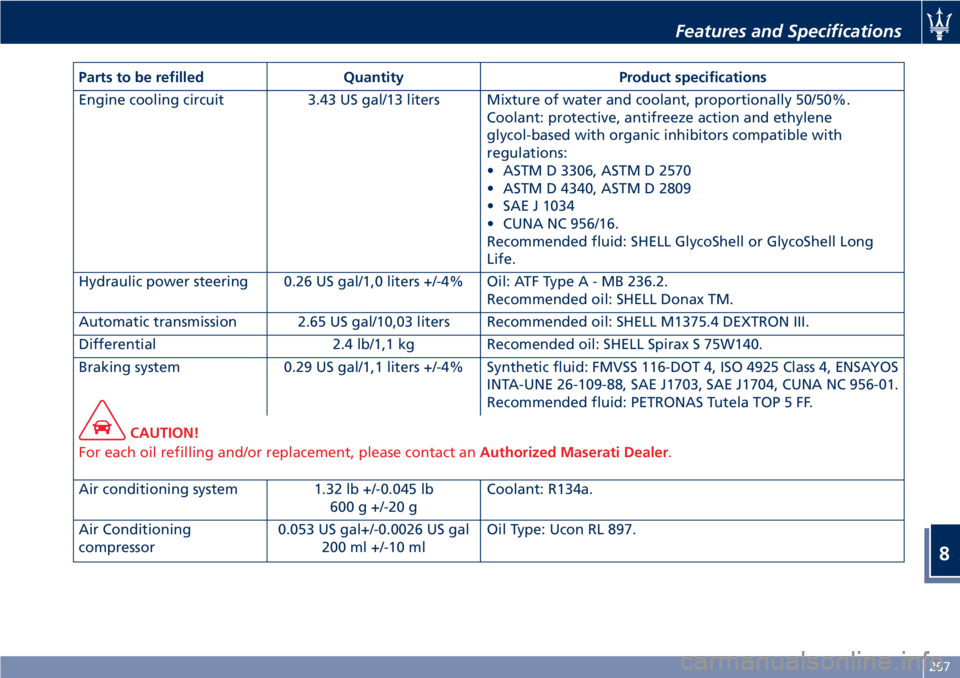2020 MASERATI GRANTURISMO engine coolant
[x] Cancel search: engine coolantPage 229 of 286

Service coupons 1° 2° 3° 4° 5° 6° 7° 8° 9° 10° 11° 12°
Main operations Maintenance schedules: every 12500 mi (20000 km) or 2 years
Air injection system: connections and pipes
valvesIIIIIIIIIIII
Blow-by systemIII II
Fuel emission control system: lines,
connections and valvesIII III
Automatic transmission oil levelIIIIIIIIIIII
Differential oil levelIIIIIIIIIIII
Hydraulic steering fluid level (bleed if
necessary)IIIIIIIIIIII
Replace at least every 2 years
Engine coolant levelIIIIIIIIIIII
Replace at least every 2 years
Brake fluid level (bleed if necessary)IIIIIIIIIIII
Replace at least every 2 years
Brake system: lines, calipers, connections -
Efficiency of the dashboard warning lights
- Parking brake operationIIIIIIIIIIII
Wear condition of the braking parts
(rotors, pads); replace if necessaryIIIIIIIIIIII
Joints for front and rear suspensions, front
and rear under-chassis – Tightening
torquesIIIIIIIIIIII
Steering system components, joint
protection, rack trunks on the steering
levers and on the axle shaftsIIIIIIIIIIII
Maintenance and Care
7
225
Page 231 of 286

Service coupons 1° 2° 3° 4° 5° 6° 7° 8° 9° 10° 11° 12°
Main operations Maintenance schedules: every 12500 mi (20000 km) or 2 years
Update navigation maps with the latest
version availableIIIIIIIIIIII
I= Inspect and carry out any other necessary operation
A= Adjust
R= Replace
NOTE:
All the operations marked with an
asterisk(*)in the “Scheduled Service
Plan” are not compulsory but rather
recommended, in the event that the
vehicle is frequently used in
heavy-traffic conditions or on dusty or
sandy roads. The warranty concerning
emissions and the Manufacturer's
responsibility to recall the vehicle in
case of problems shall not be
invalidated if the Customer does not
carry out the operations marked with
the asterisk(*).
Periodic Maintenance
Every 300 mi (500 km) or before long
journeys
Check:
• engine coolant;
• windshield washer fluid level;
• tire inflation pressure and condition;• operation of lighting system
(headlights, turn signals, hazard
warning flashers, etc.);
• operation of windshield
washer/wiper system and wear of
windshield wiper blades.
Every 1900 mi (3000 km)
Check and top up, if required, the
engine oil level.
WARNING!
California Proposition 65
Operating, servicing and maintaining
a passenger vehicle or off-road vehicle
can expose you to chemicals including
such as, engine exhaust, carbon
monoxide, phthalates and lead, that
which are know to the State of
California to cause cancer and birth
defects or other reproductive harm. To
minimize exposure, avoid breathingexhaust, do not idle the engine except
as necessary, service your vehicle in a
well-ventilated area and wear gloves
or wash your hands frequently when
servicing your vehicle. For more
information go to:
www.P65Warnings.ca.gov/passenger-
vehicle
Heavy-Duty Vehicle Use
If the car is mainly used under one of
the following conditions:
• dusty roads;
• short, repeated journeys (less than
4-5 mi/7-8 km) at sub-zero outside
temperatures;
• engine often idling or driving long
distances at low speeds or long
periods of idleness;
you should perform the following
inspections more frequently than
Maintenance and Care
7
227
Page 234 of 286

Maintenance Service
Components
1Engine oil dipstick.
2Engine oil filler neck.
3Engine coolant expansion
reservoir cap.
4Brake fluid reservoir cap.5Power steering fluid reservoir
cap.
6Windshield/headlight washer
fluid reservoir cap.
Level Checks
ENVIRONMENTAL!
•The engine oils and fluids used
contain substances that are
dangerous for the environment. For
replacement you are advised to
contact an Authorized Maserati
Dealer, where all the necessary
equipment is available to dispose of
the used oil and fluids in compliance
with the regulations in force and in
an environment-friendly manner.
•All equipment used for fluids
replacement (gloves, cloths,
containers, etc) must be disposed in
compliance with the regulations in
force.
Engine Coolant Level Check
Your vehicle has been equipped with
an improved engine coolant
(antifreeze) that offers high protection
against corrosion, freezing and allows
extended maintenance intervals. To
prevent reducing extended
maintenance periods, it is important to
use original engine coolant
(antifreeze) when adding coolant
throughout the life of your vehicle.
Maintenance and Care
7
230
Page 235 of 286

When adding engine coolant
(antifreeze) use pure water only, such
as distilled or deionized water when
mixing the water/engine coolant
(antifreeze) solution. The use of
impure water will reduce the amount
of corrosion protection in the engine
cooling system.
• Mix a minimum solution of 50%
engine coolant (antifreeze) and
distilled water. Use higher
concentrations (do not exceed 70%)
if temperatures below -35°F (-37°C)
are forecast.
Please note that it is the owner's
responsibility to maintain the proper
level of protection against freezing
according to the temperatures
occurring in the circulation area of the
vehicle.
The coolant tank provides a quick
visual method to determine that the
coolant level is adequate. As long as
the engine operating temperature is
satisfactory, the coolant bottle only
needs to be checked once a month.
With the engine off and cold, the level
of the coolant in the tank on the right
side of the engine compartment
should be between the MIN or MAX
reference notches indicated on the
tank.• When additional engine coolant
(antifreeze) is needed to maintain
the proper level, it should be added
to the coolant bottle after removing
the cap. Do not overfill.
• Once the desired level is reached,
reassemble and firmly close cap of
the tank.
• If frequent engine coolant
(antifreeze) additions are required,
or if the level in the coolant recovery
tank does not drop when the engine
cools, the cooling system should be
pressure-tested for leaks by aService
Center
• Keep the front of the radiator and
the condenser clean.
WARNING!
•Never add engine coolant
(antifreeze) when the engine is hot.Do not loosen or remove the cap of
the engine coolant bottle to cool a
hot engine. Heat causes pressure to
build up in the cooling system. To
prevent scalding or injury, do not
remove the pressure cap while the
system is hot or under pressure.
•When adding coolant do not use a
pressure cap other than the one
specified for your vehicle. Personal
injury or engine damage may result.
WARNING!
California Proposition 65
Operating, servicing and maintaining
a passenger vehicle or off-road vehicle
can expose you to chemicals including
such as, engine exhaust, carbon
monoxide, phthalates and lead, that
which are know to the State of
California to cause cancer and birth
defects or other reproductive harm. To
minimize exposure, avoid breathing
exhaust, do not idle the engine except
as necessary, service your vehicle in a
well-ventilated area and wear gloves
or wash your hands frequently when
servicing your vehicle. For more
information go to:
Maintenance and Care
7
231
Page 264 of 286

Restarting the Vehicle
Before restarting the vehicle after a
long period of inactivity, we
recommend that you carry out the
following operations.
• Check the tires for pressure and for
any damages, cuts or cracks. If this is
the case, have them replaced.
• Do not dry-rub the external surface
of the vehicle.
• Visually inspect if there are any fluid
leaks (oil, brake and clutch fluid,
engine coolant etc.).
• Have the engine oil and filter
replaced.
• Check the fluid levels in the brake
system, as well as the engine coolant
level.
• Check the air filter and have them
replaced if necessary.
• Reconnect the battery after checking
the charge status (refer to
“Maintenance-Free Battery” in this
section) and perform the initializing
procedure if applicable.
• With the transmission in N (Neutral),
let the engine idle for several
minutes.WARNING!
The engine idle must be performed
outdoors. Exhaust gases contain
carbon monoxide which is strongly
toxic and potentially lethal.
WARNING!
California Proposition 65
Operating, servicing and maintaining
a passenger vehicle or off-road vehicle
can expose you to chemicals including
such as, engine exhaust, carbon
monoxide, phthalates and lead, that
which are know to the State of
California to cause cancer and birth
defects or other reproductive harm. To
minimize exposure, avoid breathing
exhaust, do not idle the engine except
as necessary, service your vehicle in a
well-ventilated area and wear gloves
or wash your hands frequently when
servicing your vehicle. For more
information go to:
www.P65Warnings.ca.gov/passenger-
vehicle
Battery Statement
Battery Statement Status of
Charge
To avoid problems with ignition and/or
the electrical system in general when
you are driving, the battery charge
status is constantly maintained and
guaranteed by the vehicle's recharge
circuit; the main component of which
is the alternator. This circuit is only
able to supply voltage to the battery
when the vehicle is traveling.
The
warning light on the
instrument cluster (see “Instrument
Cluster” in section “Dashboard
Instruments and Controls”), will
indicate any malfunctions in the
recharge circuit or an insufficient
battery charge status (flashing).
The vehicle is fitted with advanced
electronic systems, such as, for
example, the alarm system and various
electronic control modules, which
consume power even when the key in
the ignition switch is in theSTOP (OFF)
position and the vehicle is not being
used.
Therefore, it is fundamental that the
battery is properly charged to ensure
that the engine starts properly and
Maintenance and Care
7
260
Page 271 of 286

Parts to be refilled Quantity Product specifications
Engine cooling circuit 3.43 US gal/13 liters Mixture of water and coolant, proportionally 50/50%.
Coolant: protective, antifreeze action and ethylene
glycol-based with organic inhibitors compatible with
regulations:
• ASTM D 3306, ASTM D 2570
• ASTM D 4340, ASTM D 2809
• SAE J 1034
• CUNA NC 956/16.
Recommended fluid: SHELL GlycoShell or GlycoShell Long
Life.
Hydraulic power steering 0.26 US gal/1,0 liters +/-4% Oil: ATF TypeA-MB236.2.
Recommended oil: SHELL Donax TM.
Automatic transmission 2.65 US gal/10,03 liters Recommended oil: SHELL M1375.4 DEXTRON III.
Differential 2.4 lb/1,1 kg Recomended oil: SHELL Spirax S 75W140.
Braking system 0.29 US gal/1,1 liters +/-4% Synthetic fluid: FMVSS 116-DOT 4, ISO 4925 Class 4, ENSAYOS
INTA-UNE 26-109-88, SAE J1703, SAE J1704, CUNA NC 956-01.
Recommended fluid: PETRONAS Tutela TOP 5 FF.
CAUTION!
For each oil refilling and/or replacement, please contact anAuthorized Maserati Dealer.
Air conditioning system 1.32 lb +/-0.045 lb
600 g +/-20 gCoolant: R134a.
Air Conditioning
compressor0.053 US gal+/-0.0026 US gal
200 ml +/-10 mlOil Type: Ucon RL 897.
Features and Specifications
8
267
Page 281 of 286

In the Event of an Accident. . . .203
Jump Starting Procedure......214
ToolKit..................202
Towing a Disabled Vehicle.....216
Engine
Engine Air Filter Replacement . .235
Engine Coolant Level Check. . . .230
Engine Oil Level Check.......233
Engine Overheating.........204
Engine Start Failure.........149
Engine Turn Off............149
Hood, Open and Close........38
Normal Starting of the Engine . .148
Use of the Engine...........173
EPB (Electric Parking Brake)......164
ESC (Electronic Stability Control) . .167
Filters
A/C Air Filter Replacement.....253
Engine Air Filter Replacement . .235
Fuel
Carbon Monoxide Warning. . . .191
Emergency Fuel Filler Door
Release..................193
Fuel Consumption Data.......268
Fuel Requirements..........189
Fuel System Warnings........191
Gasoline/Oxygenate Blends. . . .190
Materials Added to Fuel......191
MMT in Gasoline...........190
Reformulated Gasoline.......190
Fuses Position and Replacement. . .241HomeLink...................98
Hood, Open and Close..........38
Indicator Lights
Air bag Warning Light........66
Indicator Lights/Warning Lights
TFT Display: Warning/Indicator
Lights...................116
Warning and Indicator Lights on
Analog Instrument..........109
Inertia Switch, Fuel Cut-out......218
Infotainment System..........120
Manual Controls and Devices . .122
Installing a LATCH-Compatible Child
Restraint System.............56
Instrument Cluster............108
Interior Components...........70
Interior Maintenance and Cure . . .258
Interiors Features.............93
Jump Start Procedure.........
.215
Keys
......................22
Level Checks................230
Adding Windshield/Headlight
Washer..................233
Brake Fluid Level Check.......232
Engine Coolant Level Check. . . .230
Engine Oil Level Check.......230
Power Steering Fluid Level
Check...................235
Transmission Oil Check.......235Lights.....................83
Adaptive Bi-Xenon Headlights . . .84
Automatic Headlights.........85
Bulb Replacement..........247
Cargo Light................89
DRL, Daytime Running Lights....84
Front Domelights............88
Hazard Warning Flasher.......89
Headlights................85
High Beams and Flashing......87
Light Switch...............83
Parking Lights..............85
Rear Fog Lights.............86
Turn Signals................86
Twilight Sensor.............86
Loading the Vehicle
Vehicle Load Carrying Capacity . .97
Maintenance
A/C System Maintenance......252
Bodywork Maintenance and
Care....................255
Interior Maintenance and Care . .258
Maintenance Procedures......229
Periodic Maintenance........227
Scheduled Maintenance
Service..................222
Scheduled Service Plan.......224
Wheels Maintenance........254
Maserati Roadside Assistance
Program...................15
MIL (Malfunction Indicator Light). .109
Index
9
277